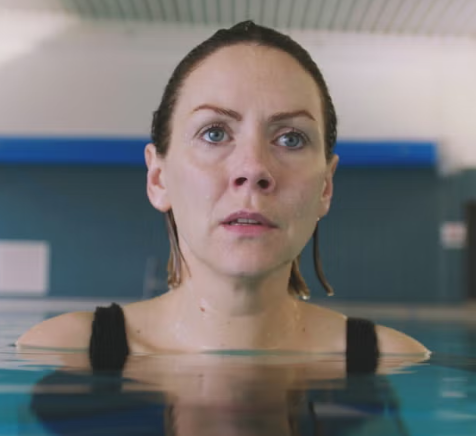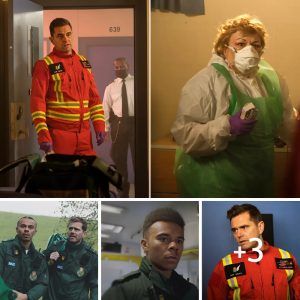In the relentless world of Holby City Hospital’s Emergency Department, few characters have faced a journey as profoundly transformative as Dr. Stevie Nash, the esteemed consultant in emergency medicine. Upcoming scenes in BBC’s long-running medical drama, Casualty, will cast a powerful spotlight on Stevie’s resilience as she attempts to reintegrate into her high-stakes professional life following a harrowing personal health crisis. Her return is not merely a physical presence but an emotional tightrope walk, as she grapples with the lingering shadows of a life-altering illness and the unspoken expectations of a demanding environment.
Stevie’s recent ordeal has been nothing short of devastating. What was initially suspected to be a pregnancy – a moment of potential new beginnings – tragically morphed into a diagnosis of a cancerous mass growing on her ovary. This devastating revelation plunged her into a battle for her life, forcing her to confront her own mortality in the most intimate and terrifying way. As her condition rapidly deteriorated, the medical team made the difficult but necessary decision to perform a hysterectomy, a radical procedure that, while saving her life, irrevocably altered her physical being and future aspirations. The subsequent period of intensive chemotherapy, a grueling regimen designed to eradicate any remaining cancerous cells, further tested her endurance, leaving her physically weakened and emotionally scarred. Yet, with a determination characteristic of her professional persona, Stevie has completed this arduous treatment and is now poised to step back onto the demanding front lines of emergency medicine.

However, the scars of such a battle are not always visible. As Stevie re-enters the fast-paced, high-pressure environment of Holby City, a subtle but persistent side effect of her chemotherapy manifests: a tingling sensation in her hands. This seemingly minor discomfort carries profound implications for a doctor whose precision and dexterity are paramount to her work. Yet, in a testament to her deep-seated desire to reclaim a semblance of normalcy and avoid special treatment, Stevie makes the conscious decision to conceal this painful sensation. Her reluctance to disclose her vulnerability stems from a profound aversion to being perceived as a “warrior” for battling cancer. She asserts, with quiet defiance, that she merely “survived it,” a statement that belies the immense internal struggle of navigating the aftermath of a life-threatening disease. This decision highlights the complex psychology of a professional determined to perform at her peak, even as her body subtly reminds her of its recent trauma.
Her first day back is anything but a gentle reintroduction. The familiar chaos of the ED quickly escalates into absolute pandemonium. Fellow consultant Flynn Byron offers a warm, initial welcome, a brief moment of camaraderie before the department is suddenly inundated with a wave of overdose patients. The scene in Resus transforms into a maelstrom of urgent medical interventions, flashing lights, and frantic shouts. Flynn, astute and experienced, quickly suspects that the heroin these patients have consumed has been lethally laced with potent synthetic opioids like nitazenes or fentanyl – substances known for their extreme potency and high risk of respiratory depression and death. The sheer volume and critical condition of these patients demand immediate, decisive action, pushing the limits of every staff member.
In the midst of this overwhelming crisis, Stevie finds herself momentarily isolated in Resus, tasked with managing multiple critical overdose cases simultaneously. The pressure is immense, requiring quick assessments, airway management, and the rapid administration of naloxone. It is during this intense period, as her trembling hands, a direct consequence of the chemo’s neurotoxic effects, betray her carefully constructed facade, that Flynn Byron intervenes. His observant eye catches the subtle tremor, and without hesitation, he takes over the most critical aspects of her immediate responsibilities, providing both support and a much-needed intervention. His calm professionalism and genuine concern for her well-being become evident in this moment of crisis.

When Flynn later confronts Stevie, gently questioning why she chose not to disclose her symptoms, her response is poignant and revealing. Her declaration – that she doesn’t want to be seen as a “warrior” but simply as someone who “just survived” – speaks volumes about the heavy burden of public expectation placed upon those who overcome serious illness. It underscores a desire to move beyond the identity of a patient and reclaim her professional identity, free from pity or special consideration. However, this stoic facade conceals a deeper, more pervasive emotional toll. Her experience with cancer has left her constantly battling a pervasive sense of fear, a gnawing anxiety that colors every aspect of her life. She is left questioning her very identity, grappling with how to reconcile the person she was before the diagnosis with the person she is becoming in its wake. The immense challenge now lies in how she can navigate these complex, often overwhelming, emotions while performing at the highest level within the relentless, life-and-death environment of Holby City Hospital. The ED, by its very nature, demands complete focus, unwavering composure, and profound resilience, all qualities that are profoundly tested when one is wrestling with internal demons.
Adding another layer of profound authenticity to Stevie’s portrayal is the personal experience of Elinor Lawless, the acclaimed actor who embodies the character. Lawless openly shared her own health struggles from childhood, a narrative that resonates deeply with Stevie’s storyline. Following a Casualty Christmas special that depicted numerous patients in desperate need of blood transfusions, Lawless reflected on her own inability to donate blood due to a congenital heart condition. She revealed to The Mirror, “I had open-heart surgery when I was seven, and because of that, I can’t give blood, and it bothers me.” This personal detail, far from being a mere anecdote, offers a crucial insight into the vulnerabilities that even medical professionals or those who appear robust may carry. Lawless articulated her frustration at not being able to participate in such a “beautifully straightforward” act of generosity, acknowledging that her own survival depended on the willingness of others. “In that situation, I was relying on other people to do the thing that I can’t do. I’m here because somebody decided to go to a blood bank that day – that’s just mind-boggling.” This profound understanding of reliance, of being on the receiving end of life-saving interventions, undoubtedly informs Lawless’s nuanced portrayal of Stevie Nash. It allows her to infuse the character with a deeper emotional truth, capturing not just the physical recovery but the profound psychological landscape of someone whose life has been irrevocably altered by a brush with mortality and who must now learn to live with a changed self and body. The empathy forged through her own childhood experiences undoubtedly allows her to access the subtle nuances of Stevie’s fear, her determination, and her quiet struggle for self-acceptance.
Stevie Nash’s narrative in Casualty is thus far more than a medical storyline; it is a profound exploration of resilience, vulnerability, and the complex process of healing – both physical and emotional. Her return to the ED, marked by a baptism of fire and the revelation of hidden struggles, promises to be a compelling and deeply human journey. It showcases the immense strength required not just to survive a life-threatening illness, but to navigate its enduring aftermath, striving for normalcy in a world that forever changed. The series continues to prove its capacity for delivering powerful, relevant drama that resonates with audiences by exploring the multifaceted challenges faced by its characters, both inside and outside the hospital walls.




